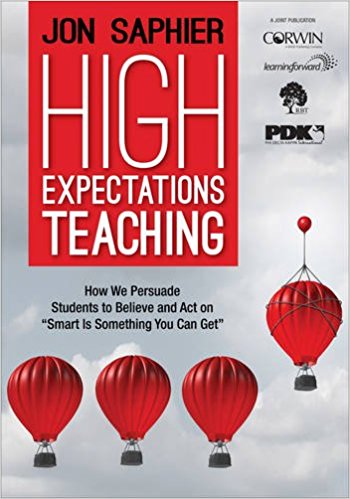High Expectations Teaching
Saphier, Jon. (2017). High Expectations Teaching. Thousand Oaks, CA: Corwin Press
The premise of this book is that educators should convince students that “smart is something you can get.” He cites 50 ways to convince students they can be successful. In order to get this result, educators have to model ways of being smart and use research-based methods to produce intelligent behaviors.
Dr. Saphier starts the book with a history tour, explaining how we arrived where we are now—using tests to determine capability. Jon does a great service to all educators by writing this history to better understand the testing culture and how we got here.
Jon writes, “Students who are on the low end of the achievement gap—usually children of color and often also of poverty—have been getting messages about their “ability” all their lives and have experienced being behind academically so long that they have bought the story. How could they not? So, if we are to eliminate the achievement gap, we have to change these students’ minds about their supposed low ability and persuade them about the benefits of becoming good students.”
He provides three goals for leaders and learners who want the best for kids.
- convince them that they can grow their ability
- show them how,
- motivate them to want to
Of course, it is never easy and some students have tremendous challenges in school and out. He continues, the challenge for us as educators is to
- get our students to believe this,
- teach them how to exert effective effort,
- make them feel known and valued
- give them high-quality instruction
Over the years we have witnessed great teachers who have a deep belief in students’ ability. Think back to your experience. Which teachers/coaches/advisors did you work the hardest for? Yes, it was those with whom you had a positive and those who would not accept the excuse “I can’t do it” and also showed you the way.
Saphier embeds powerful strategies that are based on the malleability of our intelligence. He quotes Willigham and Bruno, brain researchers at the University of Virginia, ‘’Beliefs about intelligence are important predictors of student behavior in school— Teachers should know that students are more motivated if they believe that intelligence and ability can be improved through hard work.” This is the basis of what Jeff Howard, founder and president of the Efficacy Institute, proposed in school instruction and climate. Howard was an early adopter of belief and effort can surmount may learning obstacles. Carol Dweck (Stanford) has been a champion of the “growth mindset” belief system supported by copious research. Yvette Jackson (2011 has written about this impact on student success in Pedagogy of Confidence citing anectodal and research sources.
Another quote I found particulary interesting in High Expectations Teaching is by David Perkins (Harvard, 1995) , “IQ may matter, but it does not matter overwhelmingly— statistically, a correlation coefficient of 0.5 only accounts for 25 percent of the range of variation in [academic] performance, leaving 75 percent to be explained by other factors” (Perkins, 1995, p. 61).
Saphier goes on to say that 90% to 95% of the variation in performance is probably attributable to factors other than measured IQ. As Currie puts it: “The Milwaukee Project suggests that an exclusive focus on IQ is unwarranted because other factors also contribute to children’s success at school and in life” (p. 11).
We know there are pockets of expertise in every school system and within schools. Yes, there are extremely difficult community and home situations. We educators may not be able to solve all of society’s problems, AND we can do something. Jon Saphier provides the research (theory) and a way (instructional models) to increase learning regardless of ethnicity, SES, home situations, etc.
I really liked this quote by Jeff Howard and Verna Ford, “smart is not something you are; smart is something you get (incrementally) by working hard and working smart,” There are two underlying messages in this theory.
- There is no way of telling from children’s attitudes, speech, cleanliness, clothing, record of past performance, and current performance what they are capable of learning and achieving if given time, motivation, and instruction that reaches out to meet their needs.
- Differences of color and culture have nothing to do with the capacities of children’s brains.
Jon gives strategies for educators in verbal behavior, classroom procedures that increase student responsibility, constructivist models, culturally relevant processes, parent conferences, and even recommendation for administration and organizational structures.
Saphier concludes the book by providing a formula. The formula I have always found relevant for moving people toward cultural changes (and acting from a belief in effort-based ability is surely a culture change in American education) is this:
- Say it.
- Organize for it
- Model it.
- Protect it.
- Reward it.
We at Learning Omnivores highly, did we say highly, recommend this book and support the theories and practices. The usefulness of this book enables educators to integrate these skills into their daily practices. This book would be perfect choice for a book study group.
You can order this book through Corwin Press, www.corwinpress.com
or amazon https://www.amazon.com/s/ref=nb_sb_ss_c_1_7?url=search-alias%3Daps&field-keywords=high+expectations+teaching&sprefix=High+Ex%2Caps%2C204&crid=2EX4JCNVPLPTN The contact information for Jon Saphier, Research for Better Teaching www.rbteach.com/.

